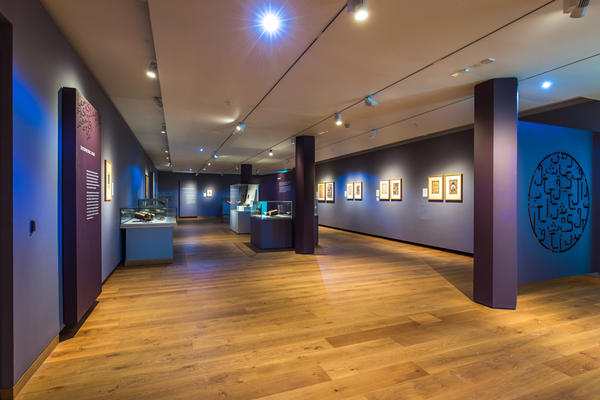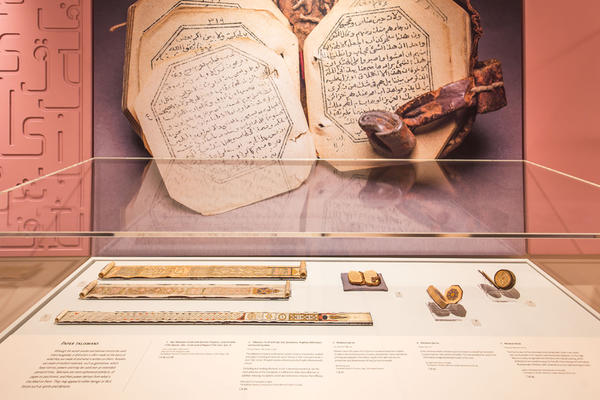Power and Protection

The research project ‘Divination and art in the Islamic world’, funded by the Leverhulme Trust, culminated in a ground-breaking exhibition at the Ashmolean Museum in 2016-17: ‘ Power and Protection: Islamic Art and the Supernatural’. This installation showcased over a hundred spectacular objects from Morocco to China, and was the first major exhibition to explore the supernatural in the art of the Islamic world.
The exhibition and related activity were also a catalyst for fresh public debate on Islamic spirituality and material culture and broadened interest in Islam and Islamic culture both within and outside the Ashmolean Museum.
About the project
Predicting, understanding and controlling the range of occult forces that influence human existence were constant preoccupations in the pre-modern world and this was no different in the Islamic sphere. From humble stone amulets with sacred invocations and Qur’anic manuscripts with divinatory tables, to instruments for astrological and geomantic calculations, Islamic material culture suggests a sustained use of practices calling for divine intercession and protection.
The project ‘Divination and art in the Islamic world’ was the first to concentrate on the material evidence produced by these activities. It took a new approach to the study of divinatory practices and their cultural significance, by placing objects at the centre of the discussion in order to provide fresh insights into the nature of these endeavours and their role in Islam's pre-modern cultural landscape.
Visitor feedback suggests that the exhibition developed around this project impacted perceptions of Islam. Many were surprised to learn the engagement of Islamic societies with divinatory practices and saw their assumptions challenged:
“an eye-opener, especially the similarities of Islam with other religions”
65-74 year-old visitor
“a great counterbalance to current discourse on Islam as rigid”
35-44 year-old female respondent
“I saw a shape I didn’t know about – sandals of the Prophet; am a Muslim, and am aware of the topic”
16-24 year-old male visitor
Select outputs
- Exhibition: Power and Protection: Islamic Art and the Supernatural, international loan exhibition curated by Francesca Leoni and held at the Ashmolean Museum of Art and Archaeology, Oxford, 20 October 2016 – 15 January 2017
- Exhibition catalogue: Francesca Leoni, ed., Power and Protection: Islamic Art and the Supernatural (Oxford; Ashmolean Museum, 2016)
- Edited Book: Francesca Leoni, Liana Saif, Matthew Melvin-Koushki and Farouk Yahya, eds., Islamicate Occult Sciences in Theory and Practice (Leiden: Brill, November 2020), 718 pp. DOI: 10.1163/9789004426979
- Blog post: Power and Protection: Islamic Art and the Supernatural
Additional outputs can be accessed via the Divination and art in the Islamic World project page on the Ashmolean Museum website.

Impacts
- The project and exhibition created an opportunity to broaden knowledge of and interest in Islamic culture among Ashmolean visitors and other stakeholders;
- 49% to 59% of the also felt that by addressing the diversity and complexity of Islamic culture, the exhibition affected their perception of Islam;
- The exhibition was referenced at least 68 times in national and international press. Media drew attention to the topic’s complexity and appeal and to the extent to which the exhibition helped to challenge conventional ideas about Islamic culture;
- The exhibition increased museum attendance and participation of under-engaged groups and occasional audiences for the Ashmolean Museum, including students, young adults and Oxford’s Muslim population;
- The exhibition played its part helping the heritage sector to grow in confidence to address a contested topic; for example, by encouraging the creation of larger display addressing divinatory, protective and healing practices in the revamped Islamic art galleries at British Museum;
- The exhibition represented a significant investment in the city of Oxford’s cultural programme and a contribution to the local economy: for example, through donations by high-profile Muslim donors and through visitor spending in Oxford and beyond.
The project was submitted as an impact case study to REF 2021; the full impact case study can be downloaded from the REF 2021 impact case study database.
Project team
Dr Francesca Leoni, Ashmolean Museum, University of Oxford
Dr Farouk Yahya, Ashmolean Museum, University of Oxford




